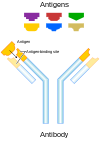Neutralizing antibody

Standard antibody representation.
|
|
| Properties | |
|---|---|
| Protein Type | Immunoglobin |
| Function | Neutralization of Antigens |
| Production | White B-cells |
A neutralizing antibody (NAb) is an antibody that defends a cell from an antigen or infectious body by neutralizing any effect it has biologically. An example of a neutralizing antibody is diphtheria antitoxin, which can neutralize the biological effects of diphtheria toxin.
Most antibodies work by binding to an antigen, signaling to a white blood cell that this antigen has been targeted, after which the antigen is processed and consequently destroyed. The difference between neutralizing antibodies and binding antibodies is that neutralizing antibodies neutralize the biological effects of the antigen, while binding antibodies flag antigens. This difference can be shown with IFN-beta;
"Antibodies can simply bind to IFN-beta or glatiramer acetate (binding Ab, or BAb) with no subsequent effect on function, or they can block or neutralize (neutralizing Ab, or NAb) their biological activity." --Mark S. Freedman, MD, MSc
This difference is what gives neutralizing antibodies the ability to fight viruses which attack the immune system, since they can neutralize function without a need for white blood cells (excluding production)
Broadly-neutralizing antibodies (bNAbs) affect multiple strains of a particular virus. BNAbs are known for HIV and influenza. Los Alamos National Laboratory's HIV Databases is a comprehensive resource that has a wealth of information about HIV sequences, bNAbs, and more.
Most mutations that shape bNAbs take place at the tips of the Y-shaped antibody molecules, which have loops to ensnare viral epitopes. bNAbs are stickier than other antibodies.
HIV viruses have only about 10 trimers on the surface versus some 450 for influenza. However, bNAbs can compensate by latching on to lipids that make up the viral membrane or even to sugars. bNAb loops are typically longer than ordinary antibodies, increasing the variety of epitopes they can capture. They also accumulate many mutations in the framework region that increase breadth and potency. These mutations do not compromise the antibody's stability, for unknown reasons.
Most bNAb sites are on HIV’s only exposed surface antigen, the flower-like envelope (Env) protein (gp120 and gp41) that sprouts from the viral membrane and is designed to grab and penetrate host cells.
...
Wikipedia
